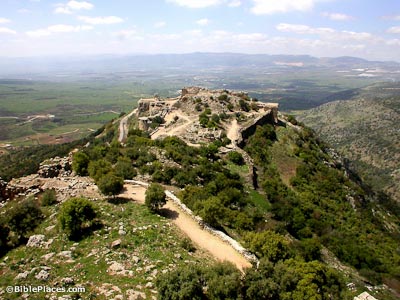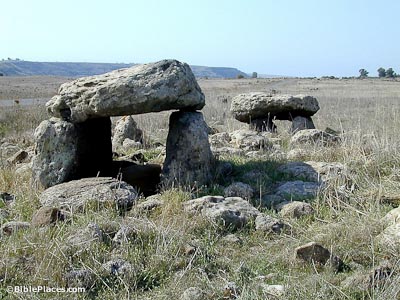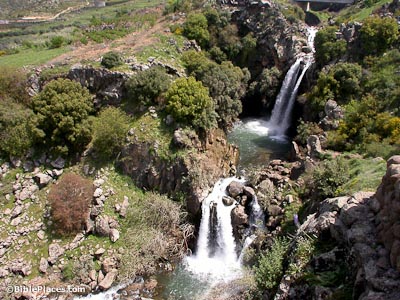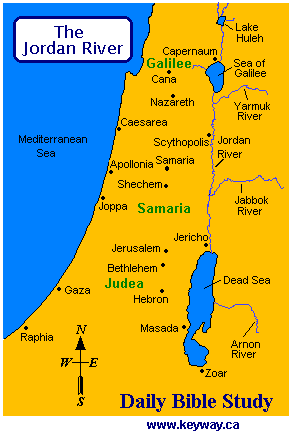THE GOLAN HEIGHTS: HISTORY AND BIBLICAL SIGNIFICANCE
by Victor Sharpe
with an addendum written by Wayne Blank
No peace with Israel.
No negotiations with Israel.
No recognition of Israel"
— Nadene Goldfoot, Apr 18 2016. here.

The British gave the Golan to France's Syrian colony in 1923 [*]. Syria attacked Israel in 1967 and lost the Golan. Syria had occupied it for 44 years. Israel's liberation of the Golan has lasted 51 years. Who has possessed the Golan the longest?
Even as modern day Syria is convulsed in a murderous and bloody civil war with untold thousands dead and maimed; even as its tyrant, Bashir al-Assad, the minority Alawite Shiite dictator, fights for his political and physical life; even with all this, he nevertheless spews forth his hatred of Israel and his call to take away the Golan Heights from the Jewish state.
But so do those "rebels" who are fighting him and thus remind us of the famous aphorism: "better the devil you know." But now two other interlopers have entered into the horrendous and bloody maelstrom that is Syria. They are Russia and Iran.
Russia, as it has since the time of Peter the Great and Catherine the Great, seeks a warm water port in the Mediterranean and a physical presence south of the Black Sea. Syria provides both.
Iran, under the irrational yoke of ayatollahs and mullahs who desire one thing — a cataclysmic nuclear war that they believe will usher in the Muslim messiah; the twelfth mahdi — are already bringing untold thousands of terrorists to the Golan border between Syrian and Israel in order to fulfill the extermination of the Jewish state, which it calls the Little Satan, and later to destroy with ICBMs the Big Satan, the United States of America.
Iran has already built military bases in Syria and continuously arms its huge terror proxy army in Lebanon and Syria, Hezb'allah, with advanced missiles and weapon systems. This terrorist horde has an army bigger than most European forces can deploy and has over 130,000 missiles aimed at Israel from southern Lebanon; all hidden in private homes, schools, hospitals and UN facilities constituting a crime against humanity and a massive threat to the civilian population of the Jewish state.
Those of us who have stood on the Golan's 1,700 foot steep escarpment, are struck by its immense strategic value overlooking Israel's fertile Hula Valley and the beautiful harp shaped lake below, called in Hebrew, Kinneret (the Sea of Galilee.)
But during Syria's occupation of the territory, no agriculture of any significance took place and no restoration of its terrain was ever undertaken. Instead, the Golan was a Syrian army artillery encampment whose sole purpose was to deliberately rain down upon Israeli farmers, fishermen and villagers an endless barrage of shells.
SO WHAT IS THE HISTORY OF THE GOLAN HEIGHTS and what is its overwhelming biblical significance to the reconstituted Jewish state? Perhaps we should return primarily to the biblical books of Joshua and Numbers.
Before the Tribes of Israel would cross the River Jordan and enter the Promised Land, the first among them had already taken possession of territory east of the River Jordan. These were the half tribes of Manasseh, Gad and Reuben who liberated the Bashan and Gilead from the Amorites.
Biblical Bashan incorporates today's Golan Heights. Gilead is the fertile land, which lies in what is the north eastern area of today's Kingdom of Jordan:
" ... a little balm, and a little honey, spices and myrrh, nuts and almonds" (Gen 43:11.)
It was Canaan, west of the Jordan, (including today's so-called West Bank) which would pose the formidable challenge to Joshua bin Nun, the general leading the Israelite tribes. So it was that Moses, the Lawgiver, spoke to the children of Gad and Reuben thus:
"Shall your brethren go to war, and shall you sit here?" (Numbers 32:6) The leaders of the two tribes replied that they would indeed send their combat men west into Canaan and fight alongside their brethren while their families would remain behind.
"We will build sheepfolds here for our cattle and cities for our little ones. But we ourselves will go ready armed before the children of Israel until we have brought them unto their place: and our little ones shall dwell in fenced cities because of the inhabitants of the land. We will not return unto our houses until the children of Israel have inherited every man his inheritance." (Numbers 32: 16-18)

THE STORY OF RECONSTITUTED ISRAEL AND ITS PEOPLE is mirrored in the biblical story of those ancient ancestors. The young men and women of modern Israel have gone again and again from their homes; be they villages, towns or cities, to the borders and established communities there in times of danger and peril, just like those young men did from the biblical tribes of Gad and Reuben.
The Jewish pioneers of today in Judea and Samaria — the biblical heartland known today falsely as the "West Bank" — are no different. But the world has chosen to demonize them as "obstacles to peace" and an impediment to the creation of a fraudulent Arab state to be called Palestine; a state that has never existed in all of recorded history; certainly not as a sovereign independent Arab state.
The pioneers are now called "settlers" and their homes and farms derisively called "settlements." It matters not to the infernal chorus that sings the international siren song of hate and ignorance that these pioneers are returned to their ancestral homesteads and seek to take up their ploughshares to sow, to plant and re-possess their ancient homeland.
But the purpose of this article is also to learn about the biblical and post-biblical history of the Jewish descendants of Gad, Reuben and Manasseh.

THE BASHAN REGION, NOW KNOWN AS THE GOLAN HEIGHTS, is a part of the biblical territory promised to the Patriarch Abraham and the people of Israel for an everlasting covenant — the Covenant of the Parts — recounted in Genesis 15. The city of Bashan was a refuge city (Deut, 4:43).
During the biblical period of the Jewish Kings, a battle high on the Golan took place between King Ahab and the army of Aram. A Jewish victory occurred at the present site of Kibbutz Afik, which lies a few miles east of Lake Kinneret, the Sea of Galilee.
After the end of the Babylonian Exile, and during the Second Temple Period, Jews returned to their homes on the Golan. Subsequently the returnees were attacked by gentiles and Judah Maccabee brought his forces up to the Heights to defend them.
At the conclusion of the Hasmonean Period, King Alexander Yannai finally re-conquered the Golan and Jews returned yet again. They rebuilt communities in central Golan, including the major cities of Banias and Susita, which formed part of the defense of the Golan.
Their residents fought heroically against the Roman legions during the Great Revolt of 135 AD, known also as the Second Uprising. It was led by the charismatic Shimon Bar Kokhba, known as the "Son of a Star" and a Jewish folk hero as great as King Arthur. Some 10,000 residents of Gamla alone perished fighting against Rome.
Second century Jewish coins were found on the Golan after its liberation during the last days of the June, 1967 Six Day War. These ancient coins were inscribed with the words, "For the Redemption of Holy Jerusalem."
In the succeeding period of the Talmudic Period, Jewish communities flourished and expanded. Archaeologists have found the remains of 34 synagogues on the Golan. Jewish life on the Golan largely ended after the defeat of the Byzantine army by Arabs from Arabia carrying the new banner of Islam and the region descended into a long period of neglect.
But Jewish life returned yet again in the latter years of the 19th century when members of the Bnei Yehuda society from Safed purchased land on the Golan. In 1891, Baron Rothschild purchased around 18,000 acres in what is present day Ramat Magshimim.

The Jewish pioneers of the First Aliyah (immigration) began to farm land they had purchased in the Horan region until the Turkish Ottoman occupiers evicted them in 1898. Their land was then seized, and in 1923 the entire Golan was given away by Britain to the French Colonial Mandate over Syria and Lebanon.
Zionist leaders had earlier demanded the Golan be included within the new Jewish National Home because of its immense historical roots in biblical and post-biblical Jewish history. But Jewish liberation of the ancestral land was not possible until Israel was forced to fight for its very survival during the 1967 Six Day War.
The Golan is only 60 miles from Haifa and the lofty slopes of Mount Hermon, the highest point in the region, have been the eyes and ears of Israel. The Golan Heights were officially annexed to Israel in 1981. But it was the left wing Israeli Prime Minister, Yitzhak Rabin, who first offered to give the Heights away in 1994.
Since then, Israelis have winced at the wrenching offers made by subsequent left leaning Israeli governments and politicians who declared publicly their desire to give the entire Heights to the Syrians in return for a delusional peace. The overwhelming majority of Israelis, however, are adamantly opposed to any such suggestion.
The Baker-Hamilton Iraq Study Group suggested that a way out for the United States from its Iraqi imbroglio would be for Israel to give the Golan Heights away to Syria. This sop, it was believed by the ISG, would bring Syria into responsible nationhood and wean her away from support of the "insurgents" attacking Iraqi and U.S assets. Of course this was before the successes of the "Surge" instituted by General Petraus made such appeasement moot.
"OBAMA'S CARROT TO THE SYRIAN DICTATOR, INEVITABLY WAS TO BE THE GOLAN HEIGHTS."
U.S. President Obama mistakenly renewed diplomatic relations with Syria as a way, he believed, of distancing the Arab dictatorship from its alliance with Iran. This was yet another delusional act by the then U.S. President whose foreign policy was predictably in tatters.
But Obama's carrot to the Syrian dictator inevitably was to be the Golan Heights. After his re-election he chose to yet again appease Arab and Muslim dictatorships by applying brutal pressure upon Israel and to force it to give away yet more of its biblical patrimony. Fortunately his malign pressure was successfully resisted.
To put any trust in a Muslim nation, especially the Iranian backed Syrian regime, is truly risky. Besides which, Iran has already stated that it's ambition is also to take the Golan from Israel at the same time that it plans on making Syria, Iraq and vast swathes of Muslim lands a future part of an all-encompassing Islamic Caliphate.
And consider this. The British colonial power gave the Golan to France's Syrian colony in 1923. Syria attacked Israel in 1967 and lost the Golan. Syria had occupied it for 44 years. Israel's liberation of the Golan has lasted 51 years. Ask yourself then, who has possessed the Golan the longest and who has millennial historic, religious, biblical and post-biblical attachment to it?
[*] When the Ottomans lost their Middle East holdings because
they fought on the losing side in World War 1, Britain primarily and France, acting
as agents of the international community, divided the land into Arab
states and one Jewish state. In 1923, Syria and Lebanon became states as part
of the French Mandate.
Editor's Addendum:
This essay is called Bashan. It was written by Wayne Blank and
is archived at
http://www.keyway.ca/htm2006/20061218.htm.
Bashan, from the Hebrew pronounced baw-shawn, meaning fertile land, was an ancient political region east of The Sea Of Galilee, running approximately from Gilead in the south to Mount Hermon in the north. Perhaps its most well-known king was Og, a giant man, one of the last, who reigned in the time of Moses i.e. "For only Og king of Bashan remained of the remnant of giants; behold, his bedstead was a bedstead of iron; is it not in Rabbath of the children of Ammon? Nine cubits was the length thereof" (Deuteronomy 3:11 KJV)
"I will bring Israel again to his habitation, and he shall feed on Carmel and Bashan"
At the time of Israel's entrance into their Promised Land, Og of Bashan made the strategic mistake of attacking The Lord as He was leading the advancing Israelites. It cost him his kingdom.

"Then we turned, and went up the way to Bashan: and Og the king of Bashan came out against us, he and all his people, to battle at Edrei. And The Lord said unto me, Fear him not: for I will deliver him, and all his people, and his land, into thy hand; and thou shalt do unto him as thou didst unto Sihon king of the Amorites, which dwelt at Heshbon.
So The Lord our God delivered into our hands Og also, the king of Bashan, and all his people: and we smote him until none was left to him remaining. And we took all his cities at that time, there was not a city which we took not from them, threescore cities, all the region of Argob, the kingdom of Og in Bashan. All these cities were fenced with high walls, gates, and bars; beside unwalled towns a great many. And we utterly destroyed them, as we did unto Sihon king of Heshbon, utterly destroying the men, women, and children, of every city. But all the cattle, and the spoil of the cities, we took for a prey to ourselves.
And we took at that time out of the hand of the two kings of the Amorites the land that was on this side Jordan, from the river of Arnon unto mount Hermon; Which Hermon the Sidonians call Sirion; and the Amorites call it Shenir; All the cities of the plain, and all Gilead, and all Bashan, unto Salchah and Edrei, cities of the kingdom of Og in Bashan." (Deuteronomy 3:1-10 KJV)
Bashan became part of the Israelite promised land (see the Fact Finder question below), given to the eastern half of the tribe of Manasseh.
"And the children of Gad and the children of Reuben answered, saying, As The Lord hath said unto thy servants, so will we do. We will pass over armed before The Lord into the land of Canaan, that the possession of our inheritance on this side Jordan may be ours.
And Moses gave unto them, even to the children of Gad, and to the children of Reuben, and unto half the tribe of Manasseh the son of Joseph, the kingdom of Sihon king of the Amorites, and the kingdom of Og king of Bashan, the land, with the cities thereof in the coasts, even the cities of the country round about." (Numbers 32:31-33 KJV)
Golan, one of the cities of Bashan, was designated as one of the Israelite Cities Of Refuge.
"And unto the children of Gershon, of the families of the Levites, out of the other half tribe of Manasseh they gave Golan in Bashan with her suburbs, to be a city of refuge for the slayer" (Joshua 21:27 KJV)
Bashan was one of Solomon's supply districts (see Solomon's Kingdom).
"And Solomon had twelve officers over all Israel, which provided victuals for the king and his household: each man his month in a year made provision ... The son of Geber, in Ramothgilead; to him pertained the towns of Jair the son of Manasseh, which are in Gilead; to him also pertained the region of Argob, which is in Bashan, threescore great cities with walls and brazen bars" (1 Kings 4:7,13 KJV)
King Hazael of Syria took Bashan from Israel when "The Lord began to cut Israel short," but it was years later recovered by King Jehoash of Israel (see Kings of Israel and Judah), unlike the modern day, when Syria, except for the Golan, again holds Bashan.
"In those days The Lord began to cut Israel short: and Hazael smote them in all the coasts of Israel; From Jordan eastward, all the land of Gilead, the Gadites, and the Reubenites, and the Manassites, from Aroer, which is by the river Arnon, even Gilead and Bashan." (2 Kings 10:32-33 KJV)
"So Hazael king of Syria died; and Benhadad his son reigned in his stead. And Jehoash the son of Jehoahaz took again out of the hand of Benhadad the son of Hazael the cities, which he had taken out of the hand of Jehoahaz his father by war. Three times did Joash beat him, and recovered the cities of Israel." (2 Kings 13:24-25 KJV)
Later historic and prophetic references to Bashan attest to the meaning of its name, fertile land (and why Solomon, as mentioned above, would have designated it as one of his supply districts).
"of rams, of lambs, and of goats, of bullocks, all of them fatlings of Bashan" (Ezekiel 39:18 KJV)
"strong bulls of Bashan" (Psalm 22:18 KJV)
"all the oaks of Bashan" (Isaiah 2:13 KJV)
"I will bring Israel again to his habitation, and he shall feed on Carmel and Bashan, and his soul shall be satisfied upon mount Ephraim and Gilead." (Jeremiah 50:19 KJV)